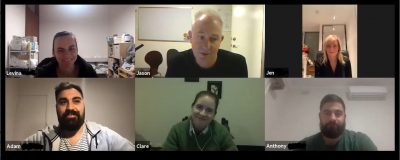How to run a strategy workshop
When was the last time you pulled the suite of smart seniors into an Oxygen-rich room, turned the phones off and took your thinking up to 35,000 feet in order to assess, imagine or sketch a few likely paths to the destination of your choosing?
That’s a challenge to do in any organisation busy with their operations. But in a world changing so fast, and on so many fronts, it’s vital to do regularly if you’re to keep your sails and tiller pointing in the right direction.
Strategy workshops are path analysis and selection discussions. Understanding and weighing the relative merits of taking road X in a shiny red Jeep, versus highway Y in a ride-sharing Prius, versus goat track Z on a second-hand monkey bike (versus doing nothing at all and waiting for the bus). Making choices about what you will prioritise, what you won’t, and why. They can be difficult conversations to hold at the right altitude. Aim too low / granular, and you end up mired in business-as-usual, immediate-impact stuff. Too high, and you get overly speculative, fluffy and disconnected from reality.
They fail when they’re either hijacked by stakeholder hobby horses, or when they’re left hanging as hypothetical imagine-a-world-full-of-robots discussions.
They need pragmatism, but higher-level-than-today pragmatism.
They need action-focus, but not whose-turn-to-empty-the-dishwasher actions.
Most of all, they need decisions. Smart, informed, weighted, ready-to-get-behind-and-push decisions. Draft versions, perhaps, but decisions the same. And decisions that are aimed at something.
Decisions made for a Purpose.
Broadly, there are seven stages you can employ to create and navigate a discussion that helps you determine and implement strategy that works for you.
1: Start with your Ultimate Trinity. Your Core Purpose, Vision and Values.
- Simon Sinek describes your Purpose as your Why. Why does your engine exist? Why bother forming and running this enterprise beyond today? Why would the world be a poorer place if you were gone? Think about it as your “legacy defined in advance”. How do you want them to remember you? What will the organisational headstone say? “They existed to……” Generally, Purpose statements are about other people – your chosen beneficiaries. Who you’ll help and how. It becomes your ultimate decision making filter for strategy – “will choice 1, or choice 2, be better to help us fulfill this Purpose?” Everything, everything, everything you elect to undertake as an enterprise should be aligned with your Purpose (or why are you wasting your time on it?)
- Then your Vision – or, as Jim Collins and Jerry Porras describe it, your big, hairy, audacious goal. The mountaintop you want to reach… for you. For your people, your shareholders. Because you think you can. An aspirational, higher-up, little-further-out statement of ambition that (if you realise it) will be a powerful enabler of your Purpose fulfillment. Some organisations opt for broad brush stroke sentiment visions (“We will be a leader in our field… the best at…”), others for black-and-white metrics (“$10 Billion @32.4% GM by 2020”). Whatever fits. It’s your Vision.
- Then your Values – your shared beliefs, your prioritised behavioural standards. There are umpteen nouns, verbs and adjectives you can pick from, and they’re all potentially positive and powerful… but which 3, 4 or 5 are truly you? Which come to the top as absolute non-negotiables that you just wouldn’t abandon in a pinch? Whether it’s “Commitment” or “Integrity” or “Speed” or “Responsibility” or “Generosity” or “Partnerships”, your values can (and should) have an aspirational feel about them… but they also have to be honest. Values are what you look for in your next hire. They’re the reason you just click with certain suppliers and collaborators. And when something gets ugly, there’s a fair chance that an incongruence of values is at play. Know yours, own them, and hold them high.
Knowing, and referencing your Purpose, Vision and Values, right from the get-go at a Strategy Workshop, is to set yourself context filters and the right compass point for the discussions to ensue.
2: Take a clear look at (and make some judgment calls on) your current operation
“The room full of mirrors” discussion. The good, bad and ugly. The S & W of the SWOT. Internal risks and leveragable. Near history review (what did we do, what worked, what didn’t, why, what did we learn?) This is helped by diversity in the room – people that can point to and interpret certain aspects of your organization from different vantage points and expertise levels. This needs to be a conversation of real honesty if it’s to be impactful. Your Strengths and Weaknesses need to be analysed in the context of your Purpose, Vision and Values (that’s the lens to determine if an attribute of your organisation is strong or weak). The bravery comes when you point to something and say “that strength needs to be leveraged and developed – it will help us” and “that weakness is dragging us down and needs to be strapped, repaired, replaced or shot”.
3: Look outside your own four walls
Marketplace analysis, external risks, opportunities, threats, trends and forces that are emerging, dissipating or persisting. Evolving movements and revolutionary sparks. There are a number of in-workshop exercises you can undertake (including finishing the SWOT, undertaking PESTLE analysis etc), and feeding the conversation in the room and in advance with stimuli and data can help open eyes and minds a little wider. Thinking pieces on parallel or contrasting industries, competitor intelligence, opinion leader views or customer input (feedback, pain points or dreams) are all valuable. Non-staff contributors can play a role in this part of the discussion – it’s an enlightened enterprise that brings a few outsiders into the inner sanctum to share their other-vantage-point perspectives for consideration in your strategy talks.
4: Open the big questions box
With a refreshed perspective on your ultimate filters (P, V & V), a clearer look at your enterprise and a look out at the market plains, now comes the big question asking;
- Will continuing unchanged along our current path get us where we want or need to be?
- Where is it clear we are ill prepared, under resourced, deficient in ability or not able to compete?
- What are we doing that remains critically important, that will underpin and fuel our progress?
- What of our Differentiating Value Proposition – that which makes us sustainably relevant and valuable to others?
- What choke points do we need to stent, or close, or take control of?
- What pace, expertise level, accuracy, quality, horsepower do we need to adopt or adapt?
- What are we deep into that we need to persist with… through?
- What, in the sober light of day, simply appears as if it can’t do what we’d designed it to do (and needs shutting down)?
- What’s not yet on the project list that needs to find its way on there if we’re serious?
- Where are our most vital-to-close gaps?
- Where are our most advantageous super-powers?
- And what, given a finite pot of time, money, talent and appetite, do we need to put the greatest amount of energy and emphasis on in the months, year and years ahead?
There’s a great opportunity to go into “What if” territory here, and that’s often a function of the culture / bravery / head-space of the leaders. There are many proven workshop constructs and exercises that can help this (“The Creativity Formula” from Inventium is a good resource). If you’re going to open the conversation to the big blue sky, have a plan for navigating it in advance – they have a number of tripwires that can harm otherwise terrific ideas and ways forward.
5: Break it down into ‘BIG ROCK’ strategic priorities
The arenas you’ll most need clear policy, decisions and activity within. Look first at;
- “Thrust” (broadly, what within this priority domain are you aiming to do?)
- “Objectives” (or goals)
- “Metrics / deliverables” (how you’ll keep score, timeframes) and
- “Key projects / activities” (chunkiest things you’ll do to hit the goals)
The more common strategic priority domains centre around things like “financials”, “customers”, “our people”, “systems & processes”, “supply”, “portfolio”, “tech / innovation”, “community” etc. Mindful that the more priority domains you capture in your strategy, the more diffuse your focus becomes. Between 4 and 8 strategic priorities is common for most organisations.
A key point is that you’ll never capture the entirety of what your organisation is doing in your strategic plan. What you’re doing is selecting your emphasis areas – the factors that, through your explicit focus on them, punch above their weight in terms of longer-term impact on the organisation’s success. There will remain a “business as usual” aspect to your operations and plans that won’t be captured here, and that’s not the point. Here, in your strategy, you’re selecting your “critical few” ahead of your “trivial (and not so trivial) many”. This is decision time. This is the moment you say “yes” and “no” and get to grips with the consequences and implications of those bigger decisions.
6: Breathe
By this point, heads are spinning and swimming. You need to pause, pull back and try taking in the full picture of what you’ve been working on here. Tabling your draft decisions and priority arenas / objective / measures on butchers paper plastering a wall (while pretty old school) is a decent way of juxtaposing your thinking and seeing an entirety. Reverse engineer it. “Knowing our Purpose, Vision and Values, placed next to each other like this, do we think this summary of priorities and actions is right? Right for us? Better than the alternatives we’ve discussed? Have we, in this light, missed any alternatives?“
Interestingly, now is the moment that the blindingly obvious sometimes reveals itself. Don’t be disheartened – in this case, the end justifies the means.
This recline-and-reflect phase, it’s a truth serum moment for the crew to confront. “Is this strategy “real”, or just academic?” It’s a put-up or shut-up moment, and ultimately heads need to start nodding in agreement… or something needs to change.
7: Next steps
With a draft framework together, some “next steps” and a governance process needs to be determined. Whether that’s turning over the draft document to an individual or team to iron out the kinks or build an action plan beneath will vary. Clear though needs to be;
- How do we take this draft artifact and all the terrific thinking that’s gone into it, and get it moving? Who owns it? Who’s driving it? What will be the right first activity after leaving this room, and the next?
- How will we govern this strategy? What’s our team, our process, our commitment to ensure what was said gets done, what doesn’t get done gets altered, and how the document evolves and lives over time?
- How will we employ this strategy and the resultant plan in communication with others outside this room? To engage and align staff? To vet suppliers and prospective employees and future potential collaborators? To show the market, appropriately, what we’re about, where we’re heading and how we’re going to get there?
On the byproduct of these workshops, organisations can thrive, bumble or die. Though simple in concept, they’re challenging to work through. Having facilitated them for over a decade, if I had to list the top 3 things I’ve learned from them, I’d say;
- On the tone and courage of the senior leader(s), the process and resultant output will live or die. If the boss is bought in, huzzah. If not, pain ahead.
- Whether you’re in the most volatile or the most static industry, there should be a roughly even balance between “preserve this fundamental” and “change this before the world changes it for us” to your decision making. If you’re too heavily balanced in “stay the current course & stick to our knitting”, or you throw the baby out with the bathwater to start absolutely everything anew, there are rocks ahead with your name on them.
- The culture of your organisation will be reflected by the way you approach this, unarguably your most important conversation. How the discussion and banter flows, how the interplay plays out and decisions get made, how the conversation translates into action, is eerily reflective of how things are in your broader enterprise. Want to see change in your company culture? This is the petri dish you want to start with.
Final thought – keep the strategy summary, the sales tool, to a page. Beautify it, make it engaging and understandable, and develop the appropriate level of detail in action plans, Gantt Charts, metrics and qualitative commentary beneath it. But keep the wrap-up to a single page. That’s a touchstone everyone in your organisation can get around.
Troy Forrest is the Managing Director of Forrest Workshops (an Adelaide-based, internationally-serving workshop construction and facilitation specialist) and Strategy Road (a swarm of independent, aligned organisations in consulting, advice and professional services). He has built and facilitated over 1,200 strategy and business planning workshops with over 120 organisations in more than 40 industries. He can be contacted to discuss and support strategic planning processes – troy@strategyroad.com.au




